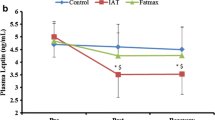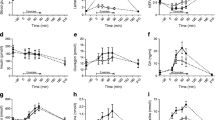Abstract
In subjects with obesity, the implementation of long-term exercise intervention increases lean tissue mass and lowers adipose tissue mass. However, data indicate a blunted lipolytic response, and/or skeletal muscle protein synthesis, when subjects with obesity are exposed to acute endurance or resistance exercise, respectively. Therefore, subjects with obesity seem to display a suboptimal physiological response to acute exercise stimuli. It might be hypothesized that hormonal disturbances contribute, at least in part, to these abnormal physiological reactions in the obese. This review discusses the impact of acute endurance and resistance exercise on endocrine hormones directly related to lipolysis and/or skeletal muscle protein synthesis (insulin, [nor]epinephrine, cortisol, growth hormone, testosterone, triiodothyronine, atrial natriuretic peptide, insulin-like growth factor-1), as well as the impact of long-term endurance and resistance exercise intervention on these hormonal responses to acute endurance and resistance exercise. In the obese, some endocrinological disturbances during acute endurance and resistance exercise have been identified: a blunted blood growth hormone, atrial natriuretic peptide and epinephrine release, and greater cortisol and insulin release. These hormonal disturbances might contribute to a suppressed lipolytic response, and/or suppressed skeletal muscle protein synthesis, as a result of acute endurance or resistance exercise, respectively. In subjects with obesity, the impact of acute endurance and resistance exercise on other endocrine hormones (norepinephrine, testosterone, triiodothyronine, insulin-like growth factor-1) remains elusive. Furthermore, whether long-term endurance and resistance exercise intervention might reverse these hormonal disturbances during acute endurance and resistance exercise in these individuals remains unknown.


Similar content being viewed by others
References
Hansen D, Dendale P, van Loon LJC, et al. The effects of training modalities on clinical benefits of exercise intervention in cardiovascular disease risk patients or type 2 diabetes mellitus. Sports Med 2010 Nov; 40 (11): 921–40
Horowitz JF. Regulation of lipid mobilization and oxidation during exercise in obesity. Exerc Sports Sci Rev 2001; 29 (1): 42–6
Augert G, Monier S, Le Marchand-Brustel Y. Effect of exercise on protein turnover in muscles of lean and obese mice. Diabetologia 1986 Apr; 29 (4): 248–53
Kolditz CI, Langin D. Adopise tissue lipolysis. Curr Opin Clin Nutr Metab Care 2010 Jul; 13: 377–81
Ahmadian M, Wang Y, Sul HS. Medicine in focus: lipolysis in adipocytes. Int J Biochem Cell Biol 2010 May; 42 (5): 555–9
Phillips BE, Hill DS, Atherton PJ. Regulation of muscle protein synthesis in humans. Curr Opin Clin Nutr Metab Care 2012; 15 (1): 58–63
Kimball SR, Jefferson LS. Control of translation initiation through integration of signals generated by hormones, nutrients, and exercise. J Biol Chem 2010 Sep; 285 (38): 29027–32
West DW, Kujbida GW, Moore DR, et al. Resistance exercise-induced increases in putative anabolic hormones do not enhance muscle protein synthesis or intracellular signalling in young men. J Physiol 2009 Nov; 587: 5239–47
McMurray RG, Hackney AC. Interactions of metabolic hormones, adipose tissue and exercise. Sports Med 2005; 25 (5): 393–412
Zouhal H, Jacob C, Delamarche P, et al. Catecholamines and the effects of exercise, training and gender. Sports Med 2008; 38 (5): 401–23
Berlin I, Berlan M, Crespo-Laumonnier B, et al. Alterations in b-adrenergic sensitivity and platelet a-adrenoreceptors in obese women: effect of exercise and caloric restriction. Clin Sci 1990 Jan; 78 (1): 81–7
Ezell DM, Geiselman PJ, Anderson AM, et al. Substrate oxidation and availability during acute exercise in nonobese, obese, and post-obese sedentary females. Int J Obes Relat Metab Disord 1999 Oct; 23 (10): 1047–56
Giacca A, Groenewoud Y, Tsui E, et al. Glucose production, utilization, and cycling in response to moderate exercise in obese subjects with type 2 diabetes and mild hyperglycemia. Diabetes 1998 Nov; 47 (11): 1763–70
Gustafson AB, Farrell PA, Kalkhoff RK. Impaired plasma catcholamine response to submaximal treadmill exercise in obese women. Metabolism 1990 Apr; 39 (4): 410–7
Koppo K, Larrouy D, Marques MA, et al. Lipid mobilization in subcutaneous adipose tissue during exercise in lean and obese humans: roles of insulin and natriuretic peptides. Am J Physiol Endocrinol Metab 2010 Aug; 299 (2): E258–65
Mittendorfer B, Fields DA, Klein S. Excess body fat in men decreases plasma fatty acid availability and oxidation during endurance exercise. Am J Physiol Endocrinol Metab 2004 Mar; 286 (3): E354–62
Salvadori A, Fanari P, Mazza P, et al. Metabolic aspects and sympathetic effects in the obese subject undergoing exercise testing. Minerva Med 1993 Oct; 84 (10): 171–7
Salvadori A, Fanari P, Giacomotti E, et al. Kinetics of catecholamines and potassium, and heart rate during exercise testing in obese subjects. Eur J Nutr 2003 Aug; 42 (4): 181–7
Stich V, De Glisezinski I, Crampes F, et al. Activation of a2-adrenergic receptors impairs exercise-induced lipolysis in SCAT of obese subjects. Am J Physiol Regul Integr Comp Physiol 2000 Aug; 279 (2): R499–504
Vettor R, Macor C, Rossi E, et al. Impaired counterregulatory hormonal and metabolic response to exhaustive exercise in obese subjects. Acta Diabetol 1997 Aug; 34 (2): 61–6
Weber MA, Neutel JM, Smith DHG. Contrasting clinical properties and exercise responses in obese and lean hypertensive patients. J Am Coll Cardiol 2001 Jan; 37 (1): 169–74
Yale JF, Leiter LA, Marliss EB. Metabolic responses to intense exercise in lean and obese subjects. J Clin Endocrinol Metab 1989 Feb; 68 (2): 438–45
Goodpaster B, Wolfe RR, Kelley DE. Effect of obesity on substrate utilization during exercise. Obes Res 2002 Jul; 10 (7): 575–84
Gossain VV, Srivastava L, Rovner DR, et al. Plasma glucagon in simple obesity: effect of exercise. Am J Med Sci 1983 Nov-Dec; 286 (3): 4–10
Bray GA, Whipp BJ, Koyal SN, et al. Some respiratory and metabolic effects of exercise in moderately obese men. Metabolism 1977 Apr; 26 (4): 403–12
Kanaley JA, Weatherup-Dentes MM, Jaynes EB, et al. Obesity attenuates the growth hormone response to exercise. J Clin Endocrinol Metab 1999 Sep; 84 (9): 3156–61
Hansen AP. Serum growth hormone response to exercise in non-obese and obese normal subjects. Scand J Clin Lab Invest 1973; 31: 175–8
Salvadori A, Fanari P, Marzullo P, et al. Dynamics of GH secretion during incremental exercise in obesity, before and after a short period of training at different work-loads. Clin Endocrinol 2010 Oct; 73 (4): 491–6
Weltman A, Weltman JY, Watson Winfield DDW, et al. Effects of continuous versus intermittent exercise, obesity, and gender on growth hormone secretion. J Clin Endocrinol Metab 2008 Dec; 93 (12): 4711–20
Wong T, Harber V. Lower excess postexercise oxygen consumption and altered growth hormone and cortisol responses to exercise in obese men. J Clin Endocrinol Metab 2006 Feb; 91 (2): 678–86
Jocken JWE, Blaak EE. Catecholamine-induce lipolysis in adipose tissue and skeletal muscle in obesity. Physiol Behav 2008 May; 94 (2): 219–30
Ormsbee MJ, Choi MD, Medlin JK, et al. Regulation of fat metabolism during resistance exercise in sedentary lean and obese men. J Appl Physiol 2009 May; 106 (5): 1529–37
Chatzinikolaou A, Fatouros I, Petridou A, et al. Adipose tissue lipolysis is upregulated in lean and obese men during acute resistance exercise. Diabetes Care 2008 Jul; 31 (7): 1397–9
Kraemer WJ, Dunn-Lewis C, Comstock BA, et al. Growth hormone, exercise, and athletic performance: a continued evolution of complexity. Curr Sports Med Rep 2010 Jul- Aug; 9 (4): 242–52
Dall R, Kanaley J, Hansen TK, et al. Plasma ghrelin levels during exercise in healthy subjects and in growth hormonedeficient patients. Eur J Endocrinol 2002 Jul; 147 (1): 65–70
Surya S, Horowitz JF, Goldenberg N, et al. The pattern of growth hormone delivery to peripheral tissues determines insulin-like growth factor-1 and lipolytic responses in obese subjects. J Clin Endocrinol Metab 2009 Aug; 94 (8): 2828–34
Nam SY, Marcus C. Growth hormone and adipocyte function in obesity. Horm Res 2000; 53Suppl1: 87–97
Widdowson WM, Healy ML, Sönksen PH, et al. The physiology of growth hormone and sport. Growth Horm IGF Res 2009 Aug; 19 (4): 308–19
Thomas GA, Kraemer WJ, Kennett MJ, et al. Immunoreactive and bioactive growth hormone responses to resistance exercise in men who are lean or obese. J Appl Physiol 2011 Aug; 111 (2): 465–72
Mastorakos G, Pavlatou M, Diamanti-Kandarakis E, et al. Exercise and the stress system. Hormones 2005 Apr-Jun; 4 (2): 73–89
Xu C, He J, Jiang H, et al. Direct effect of glucocorticoids on lipolysis in adipocytes. Mol Endocrinol 2009 Aug; 23 (8): 1161–70
Schakman O, Gilson H, Thissen JP. Mechanisms of glucocorticoid- induced myopathy. J Endocrinol 2008 Apr; 197: 1–10
Kraemer WJ, Ratamess NA. Hormonal responses and adaptations to resistance exercise and training. Sports Med 2005; 35 (4): 339–61
Gatti R, De Palo EF. An update: salivary hormones and physical exercise. Scand J Med Sci Sports 2011 Apr; 21 (2): 157–69
Thomas GA, Kraemer WJ, Comstock BA, et al. Effects of resistance exercise and obesity level on ghrelin and cortisol in men. Metabolism. Epub 2011 Dec 5
Seino S, Shibasaki T, Minami K. Dynamics of insulin secretion and the clinical implications for obesity and diabetes. J Clin Invest 2011 Jun; 121 (6): 2118–25
Bolster DR, Jefferson LS, Kimball SR. Regulation of protein synthesis associated with skeletal muscle hypertrophy by insulin-, amino acid-, and exercise-induced signalling. Proc Nutr Soc 2004 May; 63 (2): 351–6
Frosig C, Richter EA. Improved insulin sensitivity after exercise: focus on insulin signalling. Obesity 2009 Dec; 17 (S3): 15–20
Hargreaves M, Spriet L. Exercise Metabolism. Champaign (IL): Human Kinetics, 45–68
Consitt LA, Bell JA, Houmard JA. Intramuscular lipid metabolism, insulin action and obesity. IUBMB Life 2009 Jan; 61 (1): 47–55
Clerico A, Giannoni A, Vittorini S, et al. Thirty years of the heart as an endocrine organ: physiological role and clinical utility of cardiac natriuretic hormones. Am J Physiol Heart Circ Physiol 2011 Jul; 301: H12–20
Lafontan M, Moro C, Berlan M, et al. Control of lipolysis by natriuretic peptides and cyclic GMP. Trends Endocrinol Metab 2008 May-Jun; 19 (4): 130–7
Moro C, Polak J, Hejnova J, et al. Atrial natriuretic peptide stimulates lipid mobilization during repeated bouts of endurance exercise. Am J Physiol Endocrinol Metab 2006 May; 290 (5): E864–9
Crewther B, Keogh J, Cronin J, et al. Possible stimuli for strength and power adaptation. Sports Med 2006; 36 (3): 215–38
Copeland JL, Heggie L. IGF-1 and IGFBP-3 during continuous and interval exercise. Int J Sports Med 2008; 29: 182–7
Glass DJ. Signaling pathways perturbing muscle mass. Curr Opin Clin Nutr Metab Care 2010 May; 13 (3): 225–9
Nedvidkova J, Haluzik M, Bartak V, et al. Changes of noradrenergic activity and lipolysis in the subcutaneous abdominal adipose tissue of hypo- and hyperthyroid patients: an in vivo microdialysis study. Ann NY Acad Sci 2004 Jun; 1018: 541–9
Ciloglu F, Peker I, Pehlivan A, et al. Exercise intensity and its effects on thyroid hormones. Neuroendocrinol Lett 2005 Dec; 26 (6): 830–4
Smallridge RC, Whorton NE, Burman KD, et al. Effects of exercise and physical fitness on the pituitary-thyroid axis and on prolactin secretion in male runners. Metabolism 1985 Oct; 34 (10): 949–54
Hackney A. The male reproductive system and endurance exercise. Med Sci Sports Exerc 1996 Feb; 28 (2): 180–9
Vingren JL, Kraemer WJ, Ratamess NA, et al. Testosterone physiology in resistance exercise and training. The upstream regulatory elements. Sports Med 2010 Dec; 40 (12): 1037–53
Kelijman M, Frohman LA. Enhanced growth hormone (GH) responsiveness to GH-releasing hormone after dietary manipulation in obese and nonobese subjects. J Clin Endocrinol Metab 1988 Mar; 66 (3): 489–94
Williams T, Berelowitz M, Joffe SN, et al. Impaired growth hormone responses to growth-hormone releasing factor in obesity: a pituitary defect reversed with weight reduction. N Engl J Med 1984 Nov; 311 (22): 1403–7
Acknowledgements
This study was funded by a research grant from Hartcentrum Hasselt, Belgium. The authors declare that they have no conflicts of interest.
Author information
Authors and Affiliations
Corresponding author
Rights and permissions
About this article
Cite this article
Hansen, D., Meeusen, R., Mullens, A. et al. Effect of Acute Endurance and Resistance Exercise on Endocrine Hormones Directly Related to Lipolysis and Skeletal Muscle Protein Synthesis in Adult Individuals with Obesity. Sports Med 42, 415–431 (2012). https://doi.org/10.2165/11599590-000000000-00000
Published:
Issue Date:
DOI: https://doi.org/10.2165/11599590-000000000-00000




